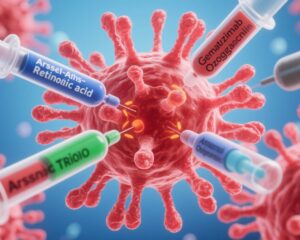Highlight
This large multicenter, randomized controlled trial rigorously compared the efficacy of oral Realgar-Indigo naturalis formula (RIF) plus all-trans retinoic acid (ATRA) versus ATRA plus arsenic trioxide (ATO) in treating non-high-risk acute promyelocytic leukemia (APL) patients. The study established the non-inferiority of RIF to ATO with a simplified and well-tolerated consolidation regimen resulting in excellent 2-year disease-free survival rates exceeding 97%. No deaths and mainly moderate adverse events were reported, supporting RIF as a promising convenient alternative to intravenous ATO in this patient subgroup.
Study Background and Disease Burden
Acute promyelocytic leukemia (APL) is a unique subtype of acute myeloid leukemia characterized by a chromosomal translocation resulting in PML-RARα fusion oncogene. This genetic hallmark renders APL exquisitely sensitive to differentiation therapy with all-trans retinoic acid (ATRA) and arsenic trioxide (ATO). These agents have transformed the prognosis of APL from a highly fatal disease to one with cure rates exceeding 90%.
Despite therapeutic advances, challenges remain in optimizing post-remission consolidation therapy. ATO, while effective, requires intravenous administration often necessitating prolonged hospital visits or admissions, which can impact patient quality of life and healthcare resource utilization. Realgar-Indigo naturalis formula (RIF) is an oral arsenic preparation derived from traditional Chinese medicine, offering a potentially more convenient route that could improve adherence and reduce costs.
This study addresses the unmet need for effective and patient-friendly consolidation therapies in non-high-risk APL, a subgroup constituting the majority of newly diagnosed cases with lower leukocyte count and less aggressive disease.
Study Design
This was a multicenter, randomized, non-inferiority trial (ClinicalTrials.gov identifier: NCT02899169) enrolling 108 eligible patients with newly diagnosed non-high-risk APL. All patients first underwent induction therapy combining ATRA with intravenous ATO to achieve hematological complete remission.
Post-induction, patients were randomly allocated to receive consolidation therapy with either ATRA plus intravenous ATO or ATRA plus oral RIF. Both arms followed a 2-week on, 2-week off cyclic regimen administered for six total cycles upon achieving molecular complete remission (defined by negativity of PML-RARα transcripts).
The primary endpoint was 2-year disease-free survival (DFS), with secondary endpoints including safety, adverse events profile, and overall survival.
Key Findings
All 108 patients achieved hematological complete remission after induction therapy. At a median follow-up of 29 months, the 2-year disease-free survival was 97% in the ATRA-RIF arm versus 98% in the ATRA-ATO arm. Statistically, the RIF regimen was non-inferior to the ATO regimen (P<0.01), with a percentage difference in DFS of -1% (95% confidence interval -4.8 to 6.9), meeting the pre-specified non-inferiority margin.
No deaths were observed in either group, reflecting excellent overall survival in this patient population.
Adverse events were mostly moderate in severity and comparable between groups. Importantly, the oral administration of RIF permitted an outpatient-friendly regimen reducing the logistical burden of intravenous therapy.
The results support that RIF-containing regimens, combined with ATRA, maintain the high efficacy benchmark previously established by intravenous ATO-based therapy in non-high-risk APL.
Expert Commentary
This study marks an important step in APL management by establishing that oral arsenic formulations can replace intravenous ATO in consolidation without compromising clinical outcomes. The ability to administer RIF orally on a simplified two-weeks-on, two-weeks-off schedule should improve patient convenience, adherence, and possibly reduce healthcare costs.
However, it is worth noting that the induction phase still utilized intravenous ATO in both arms, and whether entirely oral regimens starting from induction provide similar efficacy remains under investigation.
Additionally, generalizability outside endemic areas for RIF use or regions unfamiliar with traditional formulations requires cautious consideration, as RIF manufacturing quality control and pharmacokinetics may vary.
Mechanistically, both ATO and RIF exert anti-APL activity through induction of PML-RARα degradation and promotion of differentiation and apoptosis, providing biological plausibility for the similar outcomes observed.
Conclusion
This multicenter randomized trial confirms that oral Realgar-Indigo naturalis formula combined with ATRA is non-inferior to intravenous arsenic trioxide plus ATRA for consolidation therapy in patients with non-high-risk acute promyelocytic leukemia. The regimen offers an effective, well-tolerated, and more convenient alternative that supports outpatient management post-remission with comparable long-term disease-free survival outcomes.
Future research should address fully oral regimens including induction phases and consider real-world application in diverse healthcare settings. These findings have significant implications for patient quality of life and healthcare resource optimization in APL treatment.
References
Chen S, Qin W, Lu X, Liu L, Zheng Y, Lu X, Wang X, Zhang X, Gong S, Wei S, Zhang H, Ding H, Seifollah R, Li J, Zhang H, Wu D, Abiona O, He P, Zhang R, Wald D, Wang H. Arsenic trioxide versus Realgar-Indigo naturalis formula in non-high-risk acute promyelocytic leukemia: a multicenter, randomized trial. Haematologica. 2025 Mar 1;110(3):621-628. doi: 10.3324/haematol.2024.285905.
Lo-Coco F, Avvisati G, Vignetti M, Thiede C, Orlando SM, Iacobelli S, et al. Retinoic acid and arsenic trioxide for acute promyelocytic leukemia. N Engl J Med. 2013;369(2):111-21.
Wang ZY, Chen Z. Acute promyelocytic leukemia: from highly fatal to highly curable. Blood. 2008;111(5):2505-15.



